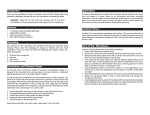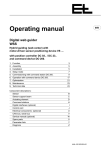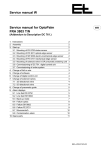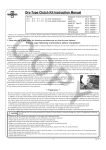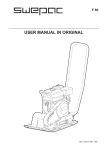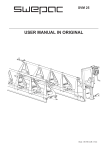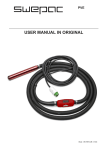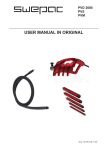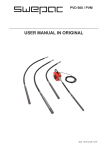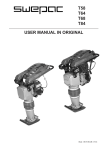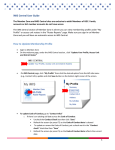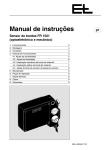Download Operating manual
Transcript
Operating manual en Digital web guider DRS, SRS Guiding by the web center with manual sensor positioning with digital guider RK 4004 and command device DO 10.. / RT 4006 1. 2. 3. 4. 5. 6. 7. 8. 9. Function Assembly Installation Setup editor Commissioning with command station DO 10.. / RT 4006 Operation with command station DO 10.. / RT 4006 Optimization Maintenance Technical data Component descriptions: Sensor Actuating element Command stations Digital interfaces (optional) Control card Electrical components (optional) CAN bus, serial bus Service manual (optional) Spare parts Parameter lists Diagrams 3 5 5 7 9 11 13 15 15 B D H I J U V W X Y Z ANL--250509-EN-01 Operating instruction notes Explanation of symbols ➜ jobs to be performed important information and instructions sections of the manual due particular attention to assure the safe operation of the web guider. Operating manual structure The E+L web guider manual consists of a general system description (A), individual component descriptions (B, C, ... W), spare parts lists (X), parameter lists (Y) and diagrams (Z). Proceed according to the operating manual instructions. All important operating procedures are explained in the manual. Where necessary, reference is made to the individual component descriptions. The block diagram includes a schematic of your system. The block diagram also includes the address settings in the case of web guiders designed by E+L. See the parameter lists for explanations of the individual setup parameters. See "Setup editor" section 4 for procedure on checking/ changing parameters. Type overview The operating manual applies for web guiders with the following actuating elements: - pivoting frame DR - steering roller SR A Seite 2 Function 1. Function 1.1 Purpose The web guider positions the moving web according to the web center. It corrects deviations from the set position and thus prevents the web wandering off to the side. The web can be oscillated within the sensor set position. 1.2 Design Actuating element Actuator AG .... Sensor Example: web guider DRS with pivoting frame and sensors The web guider consists of the following components: - two sensors for recording the actual position value - an actuating element (pivoting frame, turn rod, steering roller, reel station) with actuaor and a return-to-center switch - a digital controller DC .... or SE ..... . optional - command station DO .... - command station NT .... - command station for web offset RE .... - digital interface DI .... (e.g. CAN PLC, CAN ARCNET, CAN INTERBUS) 1.3 Operating principle To insert the web, move the actuating element to the center position and the sensors to their outer position manually. Once the web is inserted, manually position the sensors at the web edge. If the web guider is in automatic mode and the guider stop contact is enabled the web will be guided. The sensors scan the web edge position. If the web edge deviates from its set position (sensor zero pont), the sensors send the magnitude and direction of the deviation to the digital controller for evaluation. The position controller corrects the guiding criterion back to its control diagram via the actuating element. KAP--250510-EN-01 A page 3 Function 1.3.1 Oscillating mode A page 4 Use the oscillating mode to displace the web to the left/right around the set position. Use remote display DO 002. or setup parameters to set the oscillating time and stroke. On path-dependent oscillation, the oscillating time (reel station controls) is specified by the customer. The web continues to run during oscillation. Assembly / Installation 2. Assembly Please observe the locally applicable and professional safety and accident prevention regulations! 2.1 Actuating element ➜ Mount actuating element according to attached description. See also dimensioned or set-up drawing. 2.2 Sensors The sensors are pre-mounted on the actuating element (sensor support beam). In exceptional cases, see sensor and actuating element descriptions, application instructions section. 2.3 Support beam (optional) The support beam is pre-mounted on the actuating element. In exceptional cases, see support beam description. The support beam must be mounted so that the sensors are located immediately after the actuating element, see also actuating element description, application instructions section. 2.4 Digital controller The digital controller is either mounted on the actuating element or designed for mounting in a control cabinet on-site. The connection between control board and D.C. positioning drive can run in one line up to a length of 3 m. However, if the distance is between 3 m and 10 m then the motor lead and the lead of the incremental encoder MUST run seprately. 2.5 Command stations (optional) 3. Installation ➜ The command stations should be mounted in such a way that the operator actually sees the equipment he is controlling (e.g. the support beam). Please observe the locally applicable and professional safety and accident prevention regultions ! ➜ Run electrical leads according to the attached wiring diagram. 3.1 Sensor ➜ No installation work is requried for compact systems. See the sensor description for exceptions. 3.2 Support beam (optional) ➜ No installation work is required for compact systems. See the description "Suppor beams" for exceptions. KAP--250504-EN-01 A page 5 Assembly / Installation A page 6 Setup editor 4. Setup editor Parameters can be displayed and some even changed in setup mode. You can access setup and expanded setup mode via command station DO .... or operator panel RT .... . Basic operation in setup mode: Parameter Start setup mode: press the setup and additionally the increase value key (press the se tup key first). The green LED on the key will flash. Enter device number: press and hold down the setup key and select parameter 0 via the increase value key. Let go the setup key again and enter the device number via the increase or decrease value keys (device number is specified in block diagram) Enter group number: press and hold down the setup key and select parameter 1 via the increase value key. Let go the setup key again and enter the group number via the increase or decrease value keys (group number is specified in block diagram) Select and change parameter: press and hold down the setup key and select the parameter you require via the increase value key. Let go the setup key again and enter the parameter value you wish via the increase or decrease value keys. Parametervalue + Start setup mode + Enter device number or + Enter group number or + Select parameter Change parameter value or Improper parameter changes can impair the function of the entire system ! Select expanded setup mode: select device number X.5, then press and hold down the setup key and select parameter 3 via the increase value key. Let go the setup key again and enter parameter value 42 via the increase or decrease value keys . parameter value can be changed yes no + Expanded setup mode or Select further parameters yes no Quit setup mode: select device number X.5 then press and hold down the setup key and select parameter 3 via the increase value key. Let go the setup key again and enter parameter value 1 via the increase or decrease value keys. Press and hold down the setup key and press the increase value key once..Let go the setup key again. + Quit setup mode or + X is used as a stand-in for digits KAP--250505-EN-01 A page 7 Setup editor The full device address must be entered in the setup editor before the parameters of a specific device (e.g. sensor) can be changed. The device address is made up of the device and group number. All device addresses are specified in the block diagram. Parameters are selected by pressing and holding down the setup key and then pressing the increase or decrease value key until the parameter you want appears on the display. Once you let go the setup key the parameter value will appear on the display. Use the increase or decrease value keys to change the parameter value. Values are adopted or a reaction triggered by changing parameters, i.e. by selecting the next parameter. Parameters that cannot be edited must be selected and changed in expanded setup mode. A page 8 Commissioning with command station DO 10.. / RT 4006 5. Commissioning with command station DO 10.. / RT 4006 No-one must be present in the danger area around the web guider during commissioning or operation. Please observe the locally applicable and professional safety regulations. ➜ Check that the connecting leads are correctly wired. ➜ Connect all web guider devices to the operating voltage. ➜ Check the CAN bus connections. The CAN bus connection LEDs on the web guider and command stations will light up green, i.e. operational. If one of the LEDs lights up red, the corresponding CAN connection has a malfunction. Check the device and CAN cabling. ➜ Position and check sensor, set if necessary (e.g. adjustment etc.) see sensor description. This terminates the commissioning for standard applications. The settings for the following functions are listed in the descripton of the control board RK 4004: Step size for web displacement by touch control Oscillation Proportional range (amplification of control loop) Positioning speed in automatic mode Positioning speed in manual mode Reduction of positioning speed in the event of a web defect Sensor emergency operation Adaptive amplification Early warning for limit of travel Programmable digital inputs Acceleration ramp manual mode Dynamic motor current elevation KAP--250506-EN-01 A page 9 Commissioning with command station DO 10.. / RT 4006 A page 10 Operation with command station DO 10.. / RT 4006 6. Operation with command station DO 10.. / RT 4006 Only insert web when web guider and processing machine are switched off. Risk of injury! When two or more digital guiders are networked, prior to operation each individual control loop for which the following operating sequence is to apply must be selected by multifunction commandDO 0022. ➜ Enable web guider operating voltage Operating voltage display goes on. ➜ Select center mode (web guider switched off) Before inserting a new web always set the actuating element to "center" mode first. ➜ Set web offset to "0" Set web offset on command station DO 10.. to "0" (press the web offset/manual adjustment keys at the same time). Turn the web offset on command station RE 17.. (if featured) until the digital display indicates 0.0. ➜ If necessary position the sensors manually in the outside position (away from the web) ➜ Insert web ➜ Select both sensors. The LED in the relevant sensor key will shine green if sensor is selected. ➜ If necessary position sensors manually to web edge / to reference position. The sensors may only be positioned when the machine is at a standstill. Risk of injury. ➜ Set operating mode - Center mode: the actuating element is moved to the stored center position. - Manual mode: the actuating element can be moved to the desired location via the "web offset/manual adjustment" keys. - Automatic mode: if the guider stop contact is not connected, the web guider will go into automatic immediately. In automatic mode, the web can be offset via command station RE 17.. or the "web offset/manual adjustment" keys. KAP--250511-EN-01 A page 11 Operation with command station DO 10.. / RT 4006 ➜ Start processing machine If the guider stop contact is connected the web guider will not go into automatic until enabled by the guider stop contact. ➜ Set web offset Use the web offset/manual adjustment keys to offset the web within the sensor measuring range. If a command station RE 17.. is available, it alone can be used to offset the web, the "web offset/ manual adjustment" keys on DO 10../RT 4006 have no function. A page 12 Optimisation 7. Optimization 7.1 Optimization premises Amplification too high Amplification right Amplification too low Amplification is correctly set if, after brief overshooting the error is corrected. If the position controller is set with too great a degree of sensitivity, the guider will overshoot as well. In the case of too little amplification the control loop will be too slow. Optimum amplification may be determined with a characteristic curve tracer. In practice, amplification may also be determined by trial and error: While the web is controlled in the automatic mode it is necessary to shortly cover up the sensor measuring range (with a piece of cardboard for ex.) . A change of the web position will change the web path. The level-out behavior of the web guider provides further data on the amplification. The smaller the set proportional range at a constant maximum positioning velocity (Parameter ".1.6. velocity auto") is, the greater the amplification of the web guider will be. A negative proportional range causes negative amplification, the effective direction is thus inverted in automatic mode. Velocity correction established correction positioning velocity depending on proportional range Proportional range .1.3. prop range ± 2,0 3,5 15 mm/s 8 mm/s Control deviation Positioning velocity .1.6. velocity auto 20 mm/s Set position (sensor measuring range center ) Control deviation of 1.5 mm By reducing the proportional range the characteristic curve (see fig.) will become steeper. The steeper the characteristic curve the greater the positioning velocity will be in the case of a control deviation and the system thus more sensitive. The positioning velocity of the actuator may be determined on the basis of the characteristic curve regardless of the control deviation. KAP--250501-EN-01 A page 13 Optimisation In this example a proportional range of 2 mm or 3.5 mm has been assumed at a maximum motion speed of 20 mm/s. If the control deviation is 1,5 mm the following positioning velocity will result: 15 mm/s for a proportional range of 2 mm 8,0 mm/s for a proportional range of 3,5 mm The values may also be calculated arithmetically: Amplification (G) = parameter .1.6. / Parameter .1.3. Correction velocity (VK) = control deviation * amplification (G) Example 1: Example 2: 1 G = 20/2 = 10 /s G = 20/3.5 = 5.71 1/s VK = 1.5 mm * 10 1/s VK = 1.5 mm * 5.71 1/s VK = 15 mm/s VK = 8.6 mm/s Reduce the proportional range by small steps only. Following each change of the parameter value a web deviation should be produced manually in automatic mode so that oscillation may be detected immediately. Reduce the proportional range until the guider starts to oscillate. The increase the proportional range again until no more oscillation may be observed. 7.2 Optimizing the proportional range ➜ Select operational mode "Automatic" . + / . 1. 3. ➜ Select parameter ".1.3. prop range ±" . ➜ Modify parameter value as required. Smaller value = web guider more responsive Bigger value = web guider less responsive Each time the parameter value is changed the web should be deviated so that oscillation is detected immediately. Leave the setup mode after setting the proportional range. + . . 3. 1 + . . 4. ➜ Select parameter "..3. start service". ➜ Enter parameterwert 1. ➜ Select parameter "..4.". By entering "1" into parameter "..3." and then changing to another parameter a reset with data storage is activated. If two or several digital controllers are networked it is necessary to select the equipment address of the relevant web guider before selecting the parameter, see chapter "Setup-Editor". A page 14 Maintenance / Technical data 8. Maintenance Maintenance may only be performed when the web guider and processing machine are switched off . 8.1 Sensor ➜ See sensor description. 8.2 Support beam (optional) ➜ See support beam description. 8.3 Actuating element ➜ See actuating element description. 9. Technical data The technical data depend on the devices implemented and are specified in the relevant descriptions. Technical data subject to modification without notice. KAP--250502-EN-01 A page 15 Erhardt + Leimer GmbH Postfach 10 15 40 D-86136 Augsburg Telefon (0821) 24 35-0 Telefax (0821) 24 35-666
















